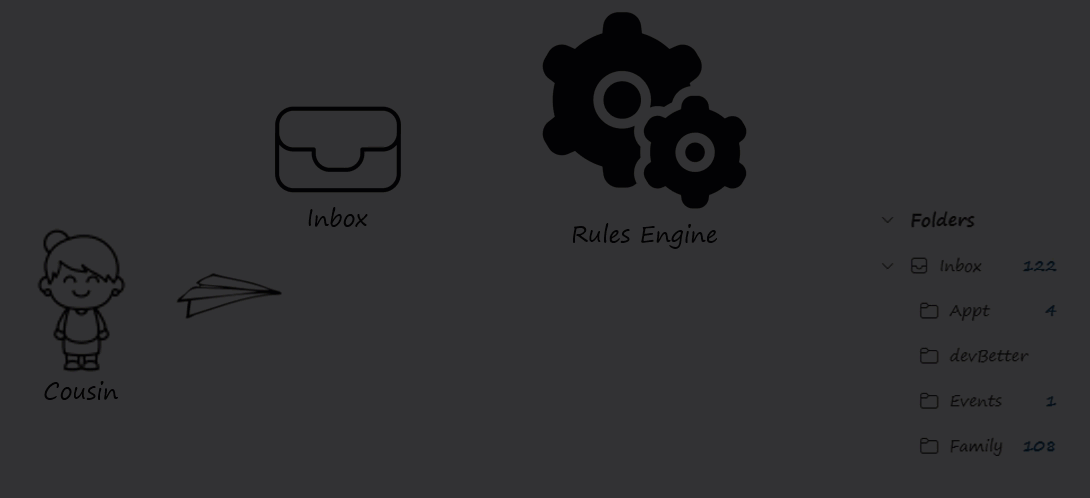DevIQ
Rules Engine Pattern
Rules Engine Pattern
The Rules Engine Pattern is classified as a behavioral design pattern, as noted in the Design Patterns book by the Gang of Four. This pattern is a design pattern that allows developers to define and manage complex business rules outside of the main application code. It encapsulates the logic for evaluating these rules and applying them to data, making it easier to modify and maintain the rules without affecting the underlying code.
The Rules Engine Pattern has three components - the rules engine, a collection of rules, and an input to which the rules need applied.
A rules engine processes a set of rules and applies the rules to generate a result. A rule describes a condition and may calculate a value.
An example of something that uses a rules engine could be your email client. If your email client allows you to set up automatic handling of email - such as filtering of emails so that you can move messages with a subject or sender to a folder, it is most likely using a rules engine.

Another example of a rules engine is when you go shopping online. Think of the stores that have 25% off of products in a particular category, individual items on sale, and also a discount for free shipping if an order hits a certain value. The 25% off of products in a particular category is a rule. Individual items on sale are separate rules. The discount for free shipping is another rule. The rules engine knows how to handle the rules, prioritizing rules, and generating the cart totals for the online shopping transaction.
Benefits of Using a Rules Engine
These are some of the benefits for using this approach:
Improved maintainability: Rules can be easily added, modified, or removed without changing the core application code.
Increased flexibility: Business rules can be adapted to changing requirements without requiring redeployment of the entire application.
Enhanced reusability: Rules can be shared and reused across different applications and domains.
Clearer separation of concerns: Business logic is separated from application code, making the code more maintainable and easier to understand.
Centralized management: Rules are managed in a centralized location, providing better control and visibility over business logic.
Classes in the Rules Engine Pattern
Sample Logic that Could Benefit from the Rules Engine Pattern
This is sample logic for the rules engine pattern using an online shop:
- All books in the Technology category are 25% off.
- All books for Publisher A are also running a deal of 20% off.
- All books released this month and this year are on sale with a 15% off discount.
- Customers who are subscribed to our newsletter may have a special custom discount count to take 30% off for their loyalty.
- If a cart has the discount code FREESHIP, then shipping is free.
If you think you would want to process this as a series of if statements, that is an option. However, the Rules Engine pattern may make more sense.
Refactoring Guidance for this Pattern
If you do have logic similar to the above with a series of if statements for processing, you can refactor your code towards the Rule Engine pattern using these steps:
- Extract the individual
ifconditions into methods. - Convert the methods into rules.
- Create the Rules Engine to evaluate the rules.
- Replace the old
ifstack with a call to the Rules Engine.
Guidance for Rules for a Rules Engine
These are some key things to note about rules:
- Each rule should follow the Single Responsibility Principle.
- In order to ensure the rule follows the Single Responsibility Principle, keep the KISS Principle in mind. Keep it simple!
- Rules may be ordered, filtered, or aggregated as necessary.
- The rules engine determines how to process the rules.
- The logic for determining priorities of the rules lives within the rules engine.
When implementing the rules engine:
- Accept the rules collection in the engine constructor.
- Apply the rules to a given input - a context or system state.
- Apply, aggregate, and filter the rules in an order appropriate for the business logic.
- Allow rules and sets of rules to be swapped via methods.
Related Patterns
- Specification Pattern - separate query logic from your application
- Chain of Responsibility - used for sequencing the rules for processing
- Strategy Pattern - encapsulate rule execution strategies
- Command - encapsulate rule actions as discrete commands for testability and separation of concerns
- Mediator Pattern - acts as the orchestrator between the Rules Engine and its dependent components
- Observer Pattern - can be used to notify parties when rules are triggered or applied
Frequently Asked Questions
❓ Is it violating Open Closed principle if the rule returns a value that includes extra information? I've got a combination of First match and aggregation.
No that’s probably fine. If your engine code gets too complex maybe you create types representing the different kinds of rules and/or their results that let you Replace Conditional with Polymorphism.
❓In the case of ordered rules, is it wrong to pass (and change) contextual information from one rule to the next?
This isn't wrong, but Chain of Responsibility might be a better fit.
References
- C# Design Patterns: Rules Engine Pattern (Pluralsight)
- Use the Decorator, Mediator, and Chain of Responsibility Patterns in C#
